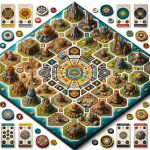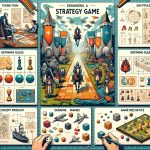Are you passionate about strategy board game design? Are you looking to create engaging and challenging gameplay mechanics? If so, you’ve come to the right place. In this article, we will explore the importance of strategy in board games and delve into the elements of successful strategy board game design. From understanding player psychology to balancing luck and skill, we’ll cover everything you need to know to become a successful strategy board game designer.
When it comes to strategy board game design, understanding the significance of strategy is crucial in creating a compelling gaming experience. Whether it’s implementing unique gameplay mechanics or creating an immersive narrative, having a strong grasp on strategic elements is essential for any aspiring game designer.
In this comprehensive guide, we will take a deep dive into the historical evolution of strategy board games and discuss how player psychology plays a pivotal role in shaping successful game designs. We will also explore key components for balancing luck and skill in strategy board games, as well as provide tips and tricks for aspiring designers. So, if you’re ready to embark on an exciting journey into the world of strategy board game design, let’s get started.
Elements of Successful Strategy Board Game Design
The elements of successful strategy board game design are essential for creating engaging and memorable gaming experiences. A well-designed strategy board game can provide players with a challenging and immersive experience that keeps them coming back for more. From the initial concept to the final gameplay mechanics, every aspect of a strategy board game must be carefully crafted to ensure balance, excitement, and replay value.
One of the key elements in successful strategy board game design is the concept of player agency. Players should feel that their decisions and actions directly impact the outcome of the game. This sense of control and responsibility can create a deep sense of engagement and investment in the gameplay experience. Additionally, providing players with multiple paths to victory and meaningful choices adds depth and replayability to a strategy board game.
Another crucial element in successful strategy board game design is balance. Balancing luck and skill is a delicate art that requires careful consideration of probability, player choices, and risk management. A well-balanced strategy board game ensures that players have agency over their decisions while also introducing an element of unpredictability that keeps the game exciting and dynamic.
Furthermore, thoughtful integration of theme and mechanics is essential in successful strategy board game design. The theme should not only be visually appealing but also deeply connected to the mechanics of the game. When players understand how their actions relate to the overarching theme, they become more immersed in the gameplay experience.
| Element | Description |
|---|---|
| Player Agency | Players should feel that their decisions directly impact the outcome of the game. |
| Balance | There should be thoughtful consideration on balancing luck and skill in a way that provides players with agency over their decisions while introducing an element of unpredictability. |
| Theme Integration | The theme should be deeply connected to the mechanics of the game, enhancing player immersion. |
Historical Evolution of Strategy Board Games
The historical evolution of strategy board games is a fascinating journey that has taken place over centuries, with various cultures contributing to the development of these games.
Ancient Origins
Many of the earliest strategy board games can be traced back to ancient civilizations such as Egypt, Mesopotamia, and China. Games like Senet, Mancala, and Go have been played for thousands of years and were often used not just for entertainment, but also for teaching strategic thinking and decision-making.
Medieval Europe
During the medieval period in Europe, strategy board games continued to evolve. Chess, considered one of the most iconic strategy board games, emerged during this time and quickly gained popularity among nobility and commoners alike. The game’s emphasis on tactical positioning and forward planning made it an instant classic that has endured for centuries.
The Modern Era
In the modern era, strategy board game design experienced a renaissance with the introduction of games like Risk and Diplomacy in the 20th century. These games introduced new mechanics such as area control and negotiation, adding depth to strategic gameplay.
This historical evolution demonstrates how strategy board game design has evolved from ancient origins to the modern era, paving the way for today’s innovative and complex games that continue to captivate players around the world.
Understanding Player Psychology in Strategy Board Game Design
The Influence of Decision-Making
One crucial aspect of strategy board game design is understanding the psychology behind decision-making. Players are often presented with various options and must make decisions that will ultimately affect the outcome of the game. As a designer, it is essential to consider how players assess risks, weigh their options, and anticipate the consequences of their decisions. Understanding player psychology in this context can help create a more engaging and immersive gaming experience.
Motivation and Reward Systems
Player motivation is another critical factor in strategy board game design. By incorporating various reward systems, such as achieving objectives, gaining resources, or unlocking new abilities, designers can tap into players’ intrinsic motivation to keep them engaged and invested in the game. Understanding what drives players to strive for success and how to implement meaningful rewards can greatly enhance the overall gameplay experience.
Social Interaction and Competition
Strategy board games often involve social interaction and competition among players. Understanding the psychological dynamics of social play, such as cooperation, competition, negotiation, and conflict resolution, can influence how games are designed to maximize player enjoyment. Additionally, considering the emotional responses that may arise during gameplay, such as joy from victory or frustration from defeat, can help designers create balanced and compelling experiences that cater to diverse player preferences.
By delving into player psychology when designing strategy board games, aspiring designers can effectively create games that resonate with their audience on a deeper level. This understanding allows for more thoughtful and intentional design choices that result in a more immersive gaming experience for players.
Key Components for Balancing Luck and Skill in Strategy Board Games
Balancing luck and skill is a crucial aspect of strategy board game design. It not only determines the level of enjoyment for players but also has an impact on the overall success of the game in the market. Finding the right equilibrium between luck and skill can be a challenging task for game designers, but it is essential for creating a satisfying gaming experience.
One key component for balancing luck and skill in strategy board games is the inclusion of varied win conditions. By allowing multiple paths to victory, players have the opportunity to utilize their strategic skills while also being open to some element of luck. This can keep the game dynamic and engaging, as it prevents one player from dominating purely due to chance or skill alone.
Another important factor in achieving this balance is through randomization mechanics such as dice rolls or card draws. These elements introduce an element of luck into the game, but strategic decision-making can still influence how these random events impact gameplay. Designers must carefully consider how much randomness to include in their games to maintain a balance between luck and skill.
Moreover, providing players with meaningful choices throughout the game is an effective way to ensure that skill plays a significant role in determining outcomes. By presenting players with decisions that require careful consideration and forward planning, designers can create a sense of agency and control that complements the presence of luck in the game. This allows skilled players to mitigate the impact of chance through their strategic choices, ultimately resulting in a well-balanced gaming experience.
| Strategy Board Game Design Component | Description |
|---|---|
| Varied Win Conditions | By including multiple paths to victory, players can showcase their strategic skills while still being open to an element of luck. |
| Randomization Mechanics | Dice rolls or card draws introduce an element of luck, but strategic decision-making can still influence outcomes. |
| Meaningful Choices | Providing players with decisions that require careful consideration ensures that skill plays a significant role in determining outcomes. |
Designing Engaging and Challenging Gameplay Mechanics
One of the most crucial aspects of strategy board game design is creating gameplay mechanics that are both engaging and challenging for players. The mechanics of a game determine how players interact with it, the choices they can make, and the way in which they can influence the outcome.
A well-designed strategy board game should provide players with a variety of options and strategies to explore, while also presenting them with meaningful challenges that require careful planning and decision-making.
In order to achieve engaging and challenging gameplay mechanics, designers must carefully balance complexity and accessibility. A game that is too complex may alienate casual players, while one that is too simplistic may fail to offer enough depth for more experienced gamers. Finding the right balance requires thoughtful consideration of the target audience, as well as extensive playtesting to ensure that the mechanics are both intuitive and deep enough to sustain long-term interest.
Moreover, variability is another key factor in creating engaging gameplay mechanics for strategy board games. By incorporating elements of randomness or variability, such as card draws or dice rolls, designers can introduce an element of unpredictability that keeps each playthrough fresh and exciting.
However, it’s important to strike a balance between luck and skill so that players feel their decisions have a meaningful impact on the outcome of the game. Achieving this delicate balance is essential for creating a memorable and enjoyable gaming experience.
Finally, in designing engaging gameplay mechanics for strategy board games, it’s important to consider player interaction. Whether through direct competition or indirect conflict, social interaction adds depth and replay value to a game by introducing new layers of strategy and decision-making. By fostering healthy competition and encouraging interaction between players, designers can create an immersive gaming experience that keeps everyone at the edge of their seats.
Case Studies of Successful Strategy Board Games
When it comes to successful strategy board game design, it’s important to look at some case studies of games that have achieved widespread popularity and critical acclaim. These examples can offer valuable insights into what makes a strategy board game truly engaging and memorable. Here are a few noteworthy case studies:
- Settlers of Catan: This iconic game designed by Klaus Teuber has become a staple in the world of strategy board games. Its simple yet strategic gameplay, along with the element of resource management, has contributed to its enduring appeal among both casual and serious gamers.
- Ticket to Ride: Designed by Alan R. Moon, this game has been praised for its elegant simplicity and deep strategy. The game mechanics, which revolve around building train routes across a map, offer a perfect balance between accessibility and depth, making it a hit among players of all ages.
- Pandemic: This cooperative board game designed by Matt Leacock has garnered widespread acclaim for its innovative gameplay and challenging cooperative experience. The way it simulates the spread of diseases around the world while requiring players to collaborate effectively showcases how a novel theme can be effectively integrated into strategic gameplay.
Studying these successful strategy board games can provide valuable insights for aspiring designers looking to create their own compelling experiences in the genre.
By analyzing the elements that have contributed to the success of these games, such as player interaction, balance between luck and skill, and innovative mechanics, designers can gain inspiration for their own creations in the field of strategy board game design. These case studies serve as living examples of how effective design principles translate into engaging gameplay experiences that stand the test of time.
Tips and Tricks for Aspiring Strategy Board Game Designers
Aspiring strategy board game designers can benefit from these tips and tricks to help them create successful and engaging games. Here are some key points to consider when delving into the world of strategy board game design:
1. Research Existing Games: Before diving into the design process, aspiring game designers should familiarize themselves with a wide variety of strategy board games. This will help them understand what has been successful in the past, as well as identify potential gaps in the market that their game could fill.
2. Focus on Clear Rules and Objectives: A key aspect of successful strategy board game design is creating clear and concise rules for players to follow. Additionally, having a defined objective for players to strive towards can help make the game more engaging and rewarding.
3. Test, Iterate, and Test Again: Once a concept has been developed, it’s important for aspiring game designers to playtest their game extensively. This will provide valuable feedback on areas that need improvement, such as balancing issues or unclear mechanics. Iterating on the game based on this feedback is crucial for creating a polished final product.
4. Embrace Player Interaction: Successful strategy board games often incorporate elements that encourage player interaction, whether it’s through negotiation, alliances, or direct conflict. Designers should consider how they can create opportunities for meaningful interaction between players within their game.
By following these tips and tricks, aspiring strategy board game designers can improve their chances of creating a compelling and successful game that resonates with players.
The Future of Strategy Board Game Design
In conclusion, the future of strategy board game design holds great potential for exciting trends and innovations. As technology continues to advance, we can expect to see an integration of digital elements into traditional board games, creating new and immersive gaming experiences. This fusion of physical and digital gameplay opens up a world of possibilities for designers to experiment with new mechanics and interactive features that will engage players in innovative ways.
Furthermore, we anticipate a greater emphasis on inclusivity and diversity in strategy board game design. Game designers are becoming more aware of the importance of representation in their games, ensuring that players from all backgrounds feel seen and included. This shift towards diversity not only enriches the gaming experience but also reflects the evolving values of society.
Lastly, as the board game industry continues to grow, there will be a heightened focus on sustainability in game production. Designers are recognizing the importance of environmentally friendly materials and manufacturing processes. This commitment to sustainability aligns with the growing awareness of environmental issues and demonstrates a responsible approach to game design. The future is bright for strategy board game design, with exciting trends and innovations on the horizon that will continue to captivate players around the world.
Frequently Asked Questions
What Makes a Good Strategy Board Game?
A good strategy board game is characterized by a clear set of rules, balanced gameplay, a healthy mix of luck and skill, and deep strategic decision-making. It should offer replay value and encourage critical thinking and planning.
How Do You Create a Strategy Game?
Creating a strategy game involves coming up with a compelling theme or concept, designing the game mechanics to provide meaningful choices for players, playtesting extensively to balance the gameplay, and refining the components to enhance the overall player experience.
How Do I Design My Own Board Game?
Designing your own board game starts with a strong concept or theme that inspires meaningful gameplay. From there, you’ll need to develop the basic rules and mechanics, prototype the game for testing, iterate based on feedback from playtests, and then prepare it for production if it’s well-received.

I love playing all kinds of games – from classics like Monopoly to modern favourites like Ticket to Ride.
I created this blog as a way to share my love of board games with others, and provide information on the latest releases and news in the industry.





